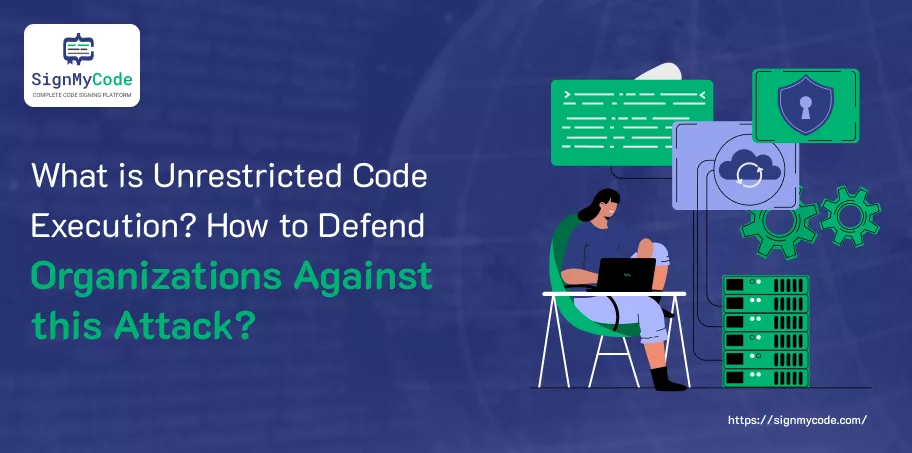What is Unrestricted Code Execution? How to Defend Organizations Against this Attack?

Nowadays, with more organizations and individuals relying heavily on third-party software to execute their high-priority and covert tasks, the risks of data breaches or cyber-attacks are becoming a serious issue.
A cyber attack is basically an attempt by cybercriminals, hackers, or other digital adversaries to access a computer network or system with a willingness to expose, alter, steal, or destroy your million-dollar information.
There can be a very wide range of victims of such cyber-attacks, ranging from individual users to organizations or even governments.
The primary goal of hackers is usually to access valuable and sensitive company resources, such as customer data, payment details, or intellectual property (IP), when it comes to targeting Organizations or businesses.
Among such cyber attacks, unrestricted or unauthorized code execution is a formidable threat, which we will discuss in this blog.
Let’s start with how it occurs.
How Unrestricted Code Execution Occurs?
It takes place when unverified programs or scripts are executed without adequate restrictions in a system. This consequence can be further exploited by threat actors to run random, malicious payloads within a network – which often leads to severe cyber security breaches.
In such scenarios, exploitation of an LLM to execute malicious commands, actions, or codes on the underlying system through natural language prompts is a very common and, at the same time, a very dangerous activity.
The code on a system gets executed without any permission, regardless of the fact whether the attacker is remote or local (has physical access).
Let’s dig a bit more to find out what vulnerabilities such a practice can create and how to mitigate and defend organizations against such unauthorized code execution attacks.
Typical Examples and Techniques of Unrestricted Code Execution
- DLLs HTML applications are very common and, hence, easily executable by attackers.
- Scripts can be in multiple languages, such as PHP, ASP, and JavaScript. Such languages are often used in web services, but they certainly aren’t restricted to those services only.
- Hence, they can be further manipulated to execute several other malicious activities without hampering the basic security alerts, which can be referred to as an unknown threat.
- There can also be some known vulnerabilities within the system that can easily be exploited by the drivers to execute unauthorized code at the kernel level, which could lead to full system compromise.
What Can Be The Vulnerabilities Within The System?
Vulnerabilities are the main culprits, and unauthorized code exploitation is the prime reason a system has to undergo vulnerability testing.
These exposed systems usually have weak links, which makes them susceptible to attack and a free target.
- Such exploitation can occur in many ways.
- It can take place through remote code execution(RCE).
- Local file inclusion is also a very common vulnerability.
- Application level command Injection attack.
- It occurs by exploiting software bugs, which allow the execution of code without proper authentication or authorization.
- Using outdated third-party libraries can lead to vulnerabilities in an application. Hence, attackers can execute arbitrary code, exploiting such vulnerabilities within the application’s context.
- When buffer data is written in a program, it generally leads to an overflow of memory locations, making it a vulnerable position.
- Attackers may use file upload functionality to upload malicious files containing executable code (e.g., PHP scripts) that trigger the execution.
- Privilege escalation allows an attacker to gain initial access to a system, which may lead to a certain point where unrestricted code execution capabilities are achieved.
Recommended Read: Top SaaS Security Risks & How to Prevent Them?
How to Defend Organizations Against Unauthorized Code Execution Attacks?
Follow the effective ways to stop or avoid this attack!
Whitelisting of Application:
Organizations should implement allowlisting to restrict applications and codes that can run on the network or system, allowing only the known and trusted. Whitelisting of applications is more secure than blacklisting (an error-prone system which can be easily manipulated).
Regular Security Audits and Monitoring:
Auditing should be a regular code of conduct. It helps to check, detect, and rectify misconfigurations or unauthorized applications. This proactive approach can quickly identify and address unauthorized processes and applications.
Awareness:
Training with comprehensive margins and management can significantly reduce the risk of social engineering tactics such as phishing attacks.
Training staff within the organization to recognize and report phishing attempts and other suspicious activities, such as unexpected slow performance or application alerts, is a must and something that can’t be ignored at any cost.
The Sandboxing Techniques:
Sandboxing isolates and tests untrusted programs and code in a secure environment to assess their viability and severity. Running new software in secure environments, such as locked-down virtual machines, helps assess its security profile.
Access Control:
Access control enables one of the major chunks of cybersecurity checks & balances, which eventually enforce strict access controls to limit the code usage and its execution, especially when a non-administrative user tries to loop in.
Try to grant minimal access rights to individuals and team members. Except for the administrative leader, refrain from allowing full access rights to any random member.
Regular Software Updates:
Updating a system and keeping it in sync with the latest security patch is a must-have. This keeps your system in daily regulation, saving it from any kind of network exploitation.
Network Segmentation:
Network Segmentation comes primarily under a damage mitigation technique. It limits the spread of any malicious code, further impacting its severity.
Automatic Downloads:
A default setting for automatic downloads can be an easy route to access your system.
Traffic Management:
A network intrusion detection system (IDS) should monitor network traffic to detect malicious activity. If an attacker tries to exploit the Visual Studio Code vulnerabilities, it is important to ensure that your IDSs are free of vulnerabilities.
Server Information:
Broadcasting default server information has become a common thread these days; Organizations should avoid such activities.
Sanitization:
A sanitization process to implement strict input validation can prevent the system from malicious or unexpected prompts.
Conclusion
As stated above, unrestricted code execution is a vital cog for safeguarding networks against the most common cyber threats.
With a combination of
- Strict application control policies,
- User education,
- Advanced techniques like sandboxing, allowlisting, etc.
The risk of unauthorized code execution can be reduced. Therefore, the solutions and strategies mentioned above can help organizations enhance their defense against one of the most pernicious threats in the cyber world.


